ZEN ART ZEN MŰVÉSZET
« Zen főoldal
« vissza a Terebess Online nyitólapjára
頂相 Dingxiang
(Rōmaji:) Chinzō (or chinsō)
(English:) Ritual portraits of Zen masters
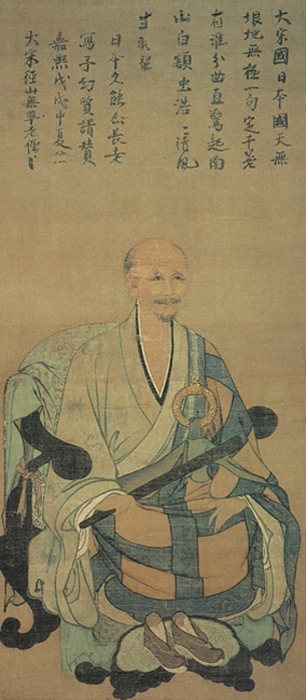
Chinzō of 無準師範 Wuzhun Shifan (1178–1249)
頂相 chinsou
http://www.aisf.or.jp/~jaanus/deta/c/chinsou.htm
Alt. reading chinzou . Lit. head's appearance. A naturalistic portrait, sculpted or painted, of a Zen master's head. Chinsou can be divided into two types depending on their function. First are inka 印可, given by a master to his disciple as a certificate of the student's attainment of spiritual awareness and as a symbol of the clear and unbroken lineage of a sect. These portraits often include hougo 法語, or words of religious enlightenment, inscribed by the priest depicted. A portrait done in a realistic and detailed style, together with an inscription, provided the disciple with both the tangible presence and the inspiration of the teaching of his master long after personal relations were severed through parting or death. Second are keshin 掛真 which were to be hung or placed together with imaginary portraits of Zen patriarchs * zenshuu soshizou 禅宗祖師像 in either the dharma hall * hattou 法堂, or main gate * sanmon 三門, of Zen sect temples in connection with memorial services. Chinsou of this second type were made after the master's death and the inscription was usually added by a close contemporary. Chinsou sculpture belongs entirely to the keshin category. The desire to symbolize the personal relationship between sitter and disciple recipient, or to memorialize a master for later followers, necessitated a high degree of verisimilitude. Moreover, the chinsou artist was encouraged to go beyond the mere physical likeness to capture something of the inner spirit of his subject. Painted chinsou are known in three formats. The most orthodox type show the priest wearing his full robe * noue 衲衣 and surplice * kesa 袈裟, seated en face in a large upholstered wooden armchair * kyokuroku 曲ろく, holding a bamboo baton shippei 竹箆 or whip kyousaku 警策 in the right hand. He is often shown with legs tucked under and shoes on a small footrest kutsudoko 沓床. A second format which evolved later was the half-length or bust portrait hanshinzou 半身像 that focuses on the individualistic details of the face. Typically in such depictions, even the hands of the priest will be hidden beneath the voluminous sleeves except for the exposed thumb of the left-hand. Orthodox painted chinsou feature a naturalistic style with fine linear details and a full range of colors, although some later examples are rendered more simply in ink monochrome. The third category may be termed special formats, including portraits of a master walking or resting * kinhinzou 経行像 and usually including landscape elements, as well as bust portraits in a circular framework * ensouzou 円相像. The chinsou tradition is said to have begun in China, possibly initiated by the needs of Japanese students. In the late 12c when Japanese priests returned from study in China, they often brought chinsou of their Chinese masters. A representative early example is the anonymous 1238 portrait of Bujun Shiban 無準師範 (Alt. reading Mujun Shihan, Ch: Wuqun Shifan) presented to the Japanese priest Enni 円爾 (Shouichi Kokushi 聖一国師; 1202-80), who on his return founded Toufukuji 東福寺. Initially Japanese Zen temples lacked the artists to produce chinsou and therefore employed portrait specialists from other sects. A good example is the 1265 portrait of Gottan Funei 兀庵普寧 (Ch: Wuan Puning; 1197-1276) by Takuma Chouga 託磨長賀, priest-painter of the esoteric temple Shoudenji 正伝寺. Early chinsou are unsigned, a fact that has greatly complicated the issue of determining the artist and even country of origin. Perhaps the earliest signed chinsou by a Japanese painter priest of a Zen sect is the portrait of Muhon Kakushin 無本覚心 by Kakue 覚恵 in Koukokuji 興国寺. By the mid 14c, Japanese artists were producing high quality chinsou as demonstrated by the anonymous 1334 portrait of Daitou Kokushi 大燈国師 (1287-1337) in Daitokuji 大徳寺 and the 1349 portrait of Musou Kokushi 夢窓国師 (1275-1351) by his disciple Mutou Shuui 無等周位 in Myouchi-in 妙智院. From the late 14c painter-priests such as Minchou 明兆 (1351-1431) produced large numbers of excellent chinsou at the ateliers of major Zen temples. The creative vigor of the chinsou tradition continued in the 15c, exemplified by the remarkable portrait of * Ikkyuu 一休 (1394-1481) in Daitokuji 大徳寺, attributed to his disciple Bokusai 墨斎 (?-1492). Chinsou were produced throughout the Edo period, with the portraits of the Oubaku 黄檗 (Ch: Huangbo) sect of special note.
Chinsō
Chinsō 頂相 are commemorative portraits of Zen masters, a traditional form of East Asian art, specifically Zen art. They can be painted or sculpted and usually present a Zen master ceremonially dressed and seated upright in chair. Chinsō include realistic portraits of prominent Zen monks, possibly commissioned by them and painted while they were alive or shortly after they died, as well as depictions of famous Zen patriarchs from the past commissioned by his disciples.
Chinsō were believed to have been passed down by Zen masters to their disciples as a symbol of dharma transmission, and known to have been meant for use in rituals, especially to represent the deceased during memorial services, and as an icon for their followers. Before monks would die, they would sometimes write a simple poem in the upper part of their portrait called eulogy, or have another author or monk write an inscription at the top. In Japan many remaining sculptural Buddhist chinsō are made out of wood, which may explain why so few remain in China and Korea on account of the Huichang persecution when most wooden sculptures perished. Some of the oldest surviving chinsō of Chan masters were brought from China to Japan; about 12 of those are extant.
1. Background and history
Chinsō flourished during the Song 960-1279 and Yuan 1279–1368 dynasties in China, and were introduced in Japan during the Kamakura period 1185–1333. They are considered historically significant because of their antiquity, preservation and artistic quality. There are about 70 known surviving chinsō from China and Japan from the 13th and 16th centuries that are designated" national treasures,” but about 10 times that number have survived in Japanese museums and temple collections.
1.1. Background and history In China
Chinsō emerged from mainstream traditions of Chinese portraiture during the Song dynasty 960–1279. Nothing visually distinguished them from other portraits done at the time of Chinese elite; the formal qualities were all the same. Chinsō are mainly understood to follow this basic formula: the monk is seated cross-legged in a chair, feet hidden, with his shoes on a footstool in front of him, in a three-quarter view, and ceremonially dressed with inner and outer robes and a kasaya or surplice draped over his left shoulder. The surplice can be held together with an ornamental ring right over the monks heart. He usually holds something in his right hand, like a whisk, scepter, staff or bamboo. They follow the highest standard for painting at the time. As well as following the same basic formula of Chinese portraiture, chinsō assumed the characteristics of Chinese portraiture in general. These included private ownership, verse inscriptions, their role in social networks. Surviving chinsō also include many works created in Japan once Zen Buddhism was brought there from China.
1.2. Background and history In Japan
When Zen Buddhism was brought to Japan from China, the Chinese style of portraiture as well as these traditions surrounding chinsō, were brought with them. This realistic style was not typical in Japan and set chinsō apart from other portraits at the time in Japan because of their high degree of verisimilitude. Although most easily identifiable chinsō have the subject seated in a chair, in three-quarter profile against a black background, with an inscription at the top, not all chinsō followed this rigid formula. The portraits of Japanese monks Mokuan Shuyu and Ikkyu Sojun represent this identifiable formula, but the alternative version of Ikkyu Sojun does not. Instead of being seated in three-quarter view, the monk or patriarch could be shown frontally, or as a full figure, and could be in a circular frame instead of simply as a figure against a blank background. Less common are chinsō showing a monk in meditation in a landscape setting, where he could be either walking or sitting. Chinsō are usually inscribed at the top with a eulogy written in free verse, describing who the patriarch was, why it was made and possibly who wrote the eulogy and why. Some scholars distinguish chinsō from the soshizō 祖師像 category, which includes portraits of legendary patriarchs from the distant past, by checking whether or not the portrait is inscribed. Its also important to note that the soshizō were not as realistic as the chinsō.
2. Origin of the term chinsō
Chinsō, or dingxiang in Chinese, is a Chinese Buddhist neologism, and was originally a translation for the Sanskrit term usnīsa. The usnisa is the term coined for the fleshy protuberance on top of the Buddhas head. In India it was said to be invisible because it is unable to be seen by living beings. During the Song dynasty in China, the term chinsō began being used for portraits of Zen monks as we know the term today. The existence of a protuberance on top of a Buddhas head represented the fact he had reached enlightenment, similar to how chinsō were thought to prove enlightenment when passed down from a monk to his disciple.
3. Functions of chinsō
Chinsō have been known to serve many purposes throughout their history. The category includes portraits commissioned by the Zen monks themselves and painted while they are alive or shortly after they had died, and portraits commissioned by famous Zen patriarchs’ disciples to be used for worship. Scholars have also concluded that they could have been used as certificates or proof of dharma transmission. By proof of dharma transmission, it is meant that the portraits were thought to have been passed down from Zen master to their disciples when they became enlightened, since dharma transmission is the recognition of the enlightenment in a monks successor and the passing down of lineage. This theory has since been questioned by scholars. Since the category of chinsō is so broad and includes portraits used for worship as well as portraits used to represent dharma transmission, the category could use stricter guidelines for classifying portrait as chinsō. The true function of chinsō is under question by scholars for the purpose of clarifying the category.
More recently since about 1994 it has come to the attention of scholars that chinsō were used in a mortuary context, rather than used to certify or authenticate dharma transmission. This was particularly the case in China. They were used after monks had died, meaning that they were used like other icons are: as a receptacle for a deity in a ritual context, like objects of worship in temples. An article by T. Griffith Foulk and Robert Sharf published in 1994 attempted to demystify this part of Zen culture by clarifying that chinsō did not serve as evidence of dharma transmission but are simply a category of Buddhist portraiture used in a mortuary context. Their inscriptions provide possible legitimization to lineage of transmission and possible affiliation, but are said to not have been given for the sole purpose of certifying enlightenment. This argument is supported by their claims that chinsō, unlike more important items for representing transmission like a monks robes, were passed out freely in China to" laymen, novices, merchants, and the like”. Their argument goes on to say chinsō could have just been part of the regular gift-giving tradition. Different recipients of chinsō include designated dharma heirs associated with specific lineages, another meaningful relation to the monk, who received the portrait as a gift or an anonymous person who received the portrait at a fundraiser a" hauzshu” in Chinese. The purpose and usage of chinsō is still in question by scholars.
Some dharma lineages have been heavily influenced by portraiture. For example, the Portrait of Chikotsu Dai’e established Chikotsu Dai’e 癡兀大慧 1229–1312 as a disciple of the Chan monk Enni Ben’e 円爾弁円1202–1280 because the inscription of the chinsō is similar to that of Enni Ben’ens on his own portrait, and Ennis is similar to that of his predecessor Wuzun Shifan 無準師範 1178–1249, a Chinese Chan monk. The portrait of Wuzun Shih-fan was brought by his disciple Enni Ben’en to Japan in 1241 and is one of the oldest surviving chinsō. Chikotsu Dai’es portrait thus establishes the genealogical sequence of Wuzun Shih-fan to Enni and then to Chikotsu. Though it is unclear if chinsō served as certificates of dharma transmission, throughout history they have been used to show a direct line of dharma transmission and lineage. The portraits of these three monks show a clear acknowledgment of enlightenment from one monk to his disciple, from Wuzun Shih-fan to Enni Ben’en to Chikotsu Dai’e. Although each monk may not have passed down their chinsō to his disciple as proof of transmission, we can understand the history of lineage as being shown through the passing down of the portraits.
Griffith Foulk and Robert Sharf, “On the Ritual Use of Ch'an Portraiture,” Cahiers d'Extrême-Asie 7 (1993/1994)
Monks seated cross-legged on a chair with shoes placed in front on a footstool (tōjō 踏床). Dressed in full ceremonial costume, with inner and outer robe (hōe 法衣) and a kasaya (surplice) (kesa 袈裟) draped over the left shoulder. The surplice of Zen lineage abbots is held together with a large ornamental ring (hekikan 璧環) that rests over the area of the heart. The priest is presented holding an implement in his right hand, typically a whisk (hossu 拂子), scepter (nyoi 如意), staff (shujō 拄杖), or bamboo staff (shippei 竹箆), all of which are proper regalia to the office of the abbot. The staff is often propped up against the chair. The chair itself may be high or low-backed, straight or with curvilinear arms, and is sometimes draped with an elaborately figured textile. Usually the sitter is in three-quarter view, although other positions are also possible. Finally, portraits are usually inscribed with a eulogy or “appreciation” (san 讃) in free verse, followed by a dedication recounting the circumstances of the production of the portrait and eulogy. (p. 157.)
http://buddhiststudies.berkeley.edu/people/faculty/sharf/documents/Sharf%20and%20Foulk%201993%20Chinzo.pdf
Zen Portraits Chinzō: Why do They Look as They do?
by Evgeny Steiner
In Memoriam? Rethinking the Portrait Sculptures of Princess-Abbesses Enshrined in the Dharma Hall at Shinnyoji Temple
by
Patricia Fister
Visual and Material Culture at Hōkyōji Imperial Convent: The Significance of “Women's Art” in Early Modern Japan
by Sharon Mitsuko Yamamoto
Obaku Zen Portrait Painting and Its Sino-Japanese Heritage
by Elizabeth Horton Sharf
In: Images in Asian Religions: Text and Contexts, UBC Press, Vancouver-Toronto, 2004, pp. 294-349.
La culture Ōbaku et le renouveau de l'art bouddhique au Japon à l'époque des Tokugawa
par
Vĕra Linhartová
Arts asiatiques, Année 2002, Volume 57, Numéro 1, pp. 114-136.
http://www.persee.fr/doc/arasi_0004-3958_2002_num_57_1_1483
Narrative agency in thirteenth-fourteenth century Chan figure painting : a study of hagiography-iconography text-image relationships
by McNeill, Malcolm L. S
Thesis (Ph.D.), SOAS University of London, 2017.
https://eprints.soas.ac.uk/24335/1/McNeill_4375.pdf
Portraits of Chan Masters I
Portraits of Chan Masters II
Portraits of Chan Masters III
Portraits of Chan Masters IV
Portraits of Chan Masters V
The 28 Indian Patriarchs
The 6 Chinese Patriarchs
DOC: Awakenings: The Development of the Zen Figural Pantheon
by Gregory Levine and Yukio Lippit (Japan Society, 2007)
https://web.archive.org/web/20081023132545/http://www.japansociety.org:80/development_zen_figural_pantheon
https://web.archive.org/web/20110709221950/http://www.japansociety.org/content.cfm/zen_awakenings
PDF: Negative Verisimilitude: The Zen Portrait in Medieval Japan
by Yukio Lippit
In: Asian Art History in the Twenty-First Century , edited by Vishaka Desai, 64-95. Williamstown: Sterling and Francine Clark Art Institute, 2007.
木像 mokuzō = wooden effigy
頂相 彫刻 chinsō chōkoku = portrait carving; usually life-size portrait sculpture in wood
仏祖諸師の肖像画|紅葉の寺 法輪山覚苑寺<下関市>
Obaku Patriarchal Portraits
http://www.kakuonji.com/busso.html
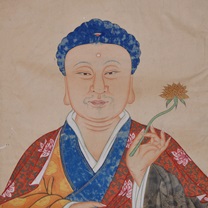 釈迦牟尼仏 Shākyamuni Buddha |
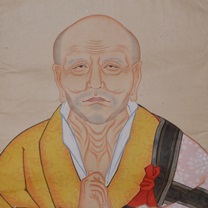 摩訶迦葉尊者 Mahākāshyapa |
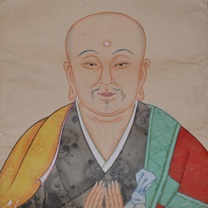 阿難尊者 Ānanda |
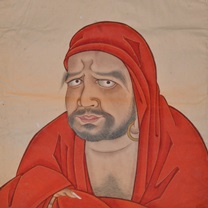 菩提達磨大師 Bodhidharma (?-532/5) |
|
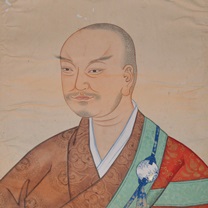 弘忍大師 Hongren (601-674) |
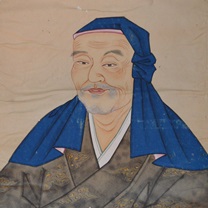 慧能大師 Huineng (638–713) |
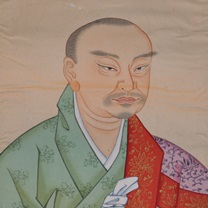 南岳懐譲禅師 Nanyue Huairang (677-744) |
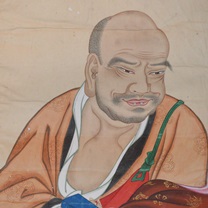 馬祖道一禅師 Mazu Daoyi (709-788) |
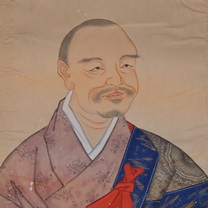 百丈懐海禅師 Baizhang Huaihai (720-814) |
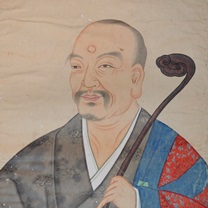 黄檗希運禅師 Huangbo Xiyun (?-850?) |
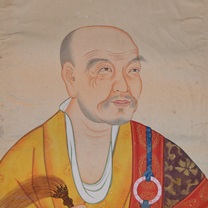 臨済義玄禅師 Linji Yixuan (?-866) |
|
|
||
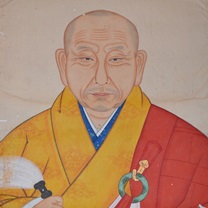 悦山道宗禅師 Yueshan Daozong (1629-1709) |
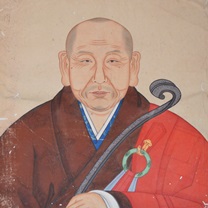 祖春元回禅師 Zuchun Yuanhui (1657-1724) |